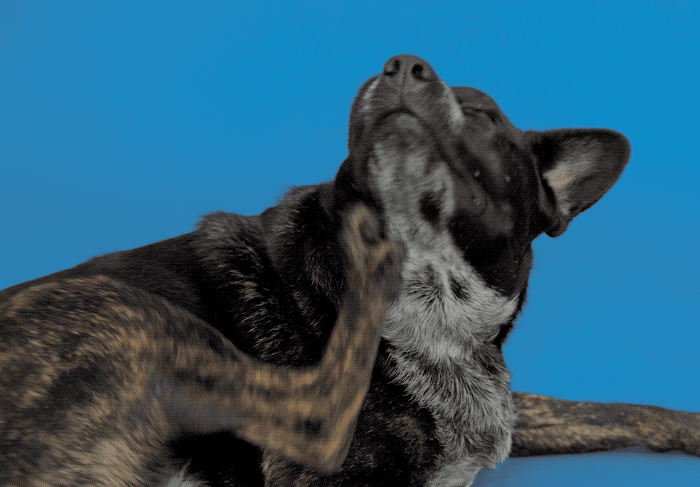For Pups With Short Attention Spans…
Skin tags on dogs are dangling folds of extra skin that can be caused by repeated friction or minor damage to an area, often pressure points. Skin tags themselves are benign and often best left alone, but if your dog seems to be experiencing discomfort it’s always a good idea to check with your vet. If your dog seems to be experiencing more skin issues that usual, increasing the number of baths and checking areas like bedding for rough spots can help reduce the irritation being caused to your pup.
Skin tags (a.k.a. acrochordons or fibroepithelial polyps) are tiny dangling folds of skin that can enlarge with time. In dogs, skin tags are benign, but may require removal if they are bothering them, repeatedly opening and bleeding, or becoming infected.


How Do I Identify a Skin Tag?
Skin tags are usually very small – we are talking millimeters here. Quite frequently, they are clustered together at a location where the skin has thickened and the hair is thinner than other areas. Common locations include where your pup rests (pressure points) like the elbows, hips and chest, or where they chafe (fiction) like armpits, under collars, or even groin (depending on your pets build). When you feel these areas, the tags are typically soft, floppy and empty. If you feel what you think is a skin tag, but it feels like it contains a small, firm ball, have your dog evaluated by your veterinarian.
What Causes Skin Tags?
Skin tags usually develop as the body’s response to minor, frequent damage to the same area, sometimes referred to as microtrauma. This is why they are most often seen at areas of pressure or friction. This can be from how dogs move without any external influences, or can be attributed to how collars, harnesses or other equipment lay on them as they move. This does not necessarily mean the animal is uncomfortable! Just that the body is responding to the stimulus. Typically, if the cause of skin tags is causing real discomfort, your pet will have other symptoms beyond just the tags.
Skin infections and allergies can contribute to the formation of skin tags, especially when untreated for extended periods of time. Just like pressure and friction damage the skin, prolonged or untreated skin conditions also cause damage that can lead to skin tags. Although, again, these pets typically have other symptoms than just skin tags. Things like redness of the skin, licking, shaking the head, and rashes may indicate there is more going on with your pet. If you’re not sure, better to get them checked out by your vet sooner than later.
Skin tags can also be idiopathic (a fancy word which simply means we don’t know what caused it). Frustrating, but true: sometimes the cause cannot be determined.
What Do I Do If My Dog Has Skin Tags?
Any time you notice a change in your dog, bring it up with your veterinarian. If the skin tags are not bothering your pet, bleeding, draining, or growing quickly, they can likely wait until your next regular visit. If you are a worrier, no judgment! I am too about my dogs. You can schedule an exam at your earliest convenience, but skin tags alone are not urgent or emergent.
What Can I Do To Prevent Skin Tags?
If your pet is very active and gets in dirt and sand while playing or swimming, bathing can reduce the amount of grit caught in the hair (which can cause friction). Make sure to use a dog-specific shampoo and rinse thoroughly. As a matter of routine, you can bathe your dog up to once a week. More frequently than that causes the skin to be dry and can increase the likelihood of skin issues. Unless directed by a veterinarian, keep your regular bathing schedule to weekly at the most. Obviously, if your dog unexpectedly covers themselves in mud or gets skunked the day after bath day, bathe them. There are exceptions to every rule of thumb!
If your pet seems to have skin tags developing at pressure points, check their bedding. Maybe they have something firm they hid stuck in their normally cushy bed. Maybe they wore a hole in the center. Maybe they are getting older and just need a little more cushion. If it’s summer, your dog may also be too hot for a traditional fluffy bed. You can try a cooling mat on its own, or on top of a padded bed to try and encourage your buddy to not lay on tile floors.
If your pet seems to be developing skin tags under a collar or harness, try and switch up the gear for a bit. Only have them wear it when you are actively using it (although your pet should always have some form of identification on to get them back to you should you get separated). Also, wash the gear! Sometimes sand or grit gets into the material, causing it to chafe and may result in skin tags.
Last but not least, a balanced diet is essential to skin health. Make sure your pet is on a complete and balanced diet and always has access to clean drinking water to support skin health. Healthy skin is less likely to develop issues, and thus is less vulnerable to skin tags. If your pet is on a complete and balanced diet but you feel like their skin is still dry, flaky, or easily irritated, discuss skin supplements with your veterinarian. Depending on what’s in your dog’s diet, supplementation may be helpful.
Final Thoughts
If your pet has skin tags, they are likely here to stay, and may even develop more with time. The good news is they are unlikely to need intervention unless they are bothering your pet. Occasionally, they will fall off or get pinched off during normal activity. Keep an eye on them, and contact your pet’s vet if you have concerns in your particular case.
Colleen Ferriman, DVM, is a canine and feline health, wellness, and illness management advocate. She has a combined 10 years of experience in clinical medicine, education, and educational content development. Colleen graduated from Colorado State University as a Doctor of Veterinary Medicine, has worked as a general practitioner, and has contributed to the development of veterinary educational tools. She is also a member of the American Veterinary Medical Association and American Academy of Veterinary Pharmacology and Therapeutics.






